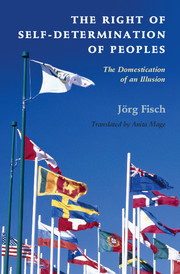Book contents
- Frontmatter
- Contents
- List of Figures
- List of Tables
- List of Maps
- Prologue – National Unity and Secession in the Symbolism of Power
- Introduction – A Concept and Ideal
- PART I THEORY OF SELF-DETERMINATION
- PART II SELF-DETERMINATION IN PRACTICE
- 5 Early Modern Europe: Precursors of a Right of Self-Determination?
- 6 The First Decolonization and the Right to Independence: The Americas, 1776–1826
- 7 The French Revolution and the Invention of the Plebiscite
- 8 From the European Restoration to the First World War, 1815–1914
- 9 The First World War and the Peace Treaties, 1918–1923
- 10 The Interwar Period, 1923–1939
- 11 The Second World War: The Perversion of a Great Promise
- 12 The Cold War and the Second Decolonization, 1945–1989
- 13 After 1989: The Quest for a New Equilibrium
- Epilogue – The Right of the Weak
- Notes
- Bibliographical Essay
- Bibliography
- Maps
- Chronological Index of Cited Legal Documents
- Index
10 - The Interwar Period, 1923–1939
from PART II - SELF-DETERMINATION IN PRACTICE
Published online by Cambridge University Press: 05 December 2015
- Frontmatter
- Contents
- List of Figures
- List of Tables
- List of Maps
- Prologue – National Unity and Secession in the Symbolism of Power
- Introduction – A Concept and Ideal
- PART I THEORY OF SELF-DETERMINATION
- PART II SELF-DETERMINATION IN PRACTICE
- 5 Early Modern Europe: Precursors of a Right of Self-Determination?
- 6 The First Decolonization and the Right to Independence: The Americas, 1776–1826
- 7 The French Revolution and the Invention of the Plebiscite
- 8 From the European Restoration to the First World War, 1815–1914
- 9 The First World War and the Peace Treaties, 1918–1923
- 10 The Interwar Period, 1923–1939
- 11 The Second World War: The Perversion of a Great Promise
- 12 The Cold War and the Second Decolonization, 1945–1989
- 13 After 1989: The Quest for a New Equilibrium
- Epilogue – The Right of the Weak
- Notes
- Bibliographical Essay
- Bibliography
- Maps
- Chronological Index of Cited Legal Documents
- Index
Summary
MAJORITIES AND MINORITIES
In the years from 1918 to 1923, the drawing of borders did not by any means occur rigorously in accordance with the viewpoints – subjective or objective – of a possible right of self-determination. The right of self-determination had become a prestigious watchword and had trumped all other criteria in its impact as a weapon of propaganda. Yet in practice, political, strategic, economic, historical, and other aspects were definitely more important. In part, the victors did not want to harm their own interests through the application of criteria that would be unfavorable for them; in part, given the topography or settlement geography of the territory in question, they could do hardly anything else except ignore aspects of self-determination. The classic dilemma of this type was the Polish Corridor.
The weight of aspects pertaining to self-determination in the delimitation of groups had nonetheless increased, especially if one added objective factors. Membership in a nationality had greater consequences in daily life for more people than in the past. This was also a consequence of the fact that national states had been created on the territories of the former multinational states. The multinational Ottoman and the Habsburg empires (and to a lesser extent Russia) had considered themselves, at least in part, as states in which a number of nationalities lived together if not with equal rights, then nevertheless without a sharp contrast between a majority that formed the national population and the minorities that were all similarly subordinate to the majority. Now almost all the states were national states at least in intent, even if in some cases two or more nationalities had to be united in one state, as with the Czechs and the Slovaks in Czechoslovakia and the Serbs, Croats, and Slovenes in Yugoslavia. The more that borders were drawn exclusively according to aspects of self-determination, the more important and far-reaching the quality of belonging to a specific nationality became.
The consequences were ambivalent. There was a substantial increase in the percentage of the European population that belonged to an (as a rule) ethnically or linguistically defined national majority. While in 1914 about sixty million people and thus about 50 percent of the population in Eastern Europe belonged to minorities, in 1920 it was only approximately thirty million and thus 25 percent.
- Type
- Chapter
- Information
- The Right of Self-Determination of PeoplesThe Domestication of an Illusion, pp. 160 - 174Publisher: Cambridge University PressPrint publication year: 2015



